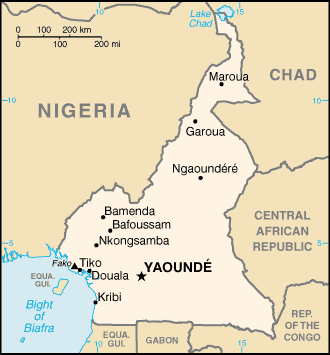Map:

Overview:
The former French Cameroon and part of British Cameroon merged in 1961 to form the present country. Cameroon has generally enjoyed stability, which has permitted the development of agriculture, roads, and railways, as well as a petroleum industry. Despite movement toward democratic reform, political power remains firmly in the hands of an ethnic oligarchy.
The People:
Population: 16,380,005
note: estimates for this country explicitly take into account the effects of excess mortality due to AIDS; this can result in lower life expectancy, higher infant mortality and death rates, lower population and growth rates, and changes in the distribution of population by age and sex than would otherwise be expected (July 2005 est.)
Age structure:
0-14 years: 41.7% (male 3,457,180/female 3,375,668)
15-64 years: 55% (male 4,537,281/female 4,477,163)
65 years and over: 3.3% (male 239,634/female 293,079) (2005 est.)
Religions:
indigenous beliefs 40%, Christian 40%, Muslim 20%
Government Type:
unitary republic; multiparty presidential regime (opposition parties legalized in 1990)
note: preponderance of power remains with the president
Leader(s) to pray for:
chief of state: President Paul BIYA (since 6 November 1982)
head of government: Prime Minister Ephraim INONI (since 8 Dec 2004)
Source: The World Factbook
View All Countries